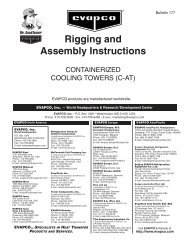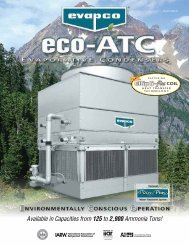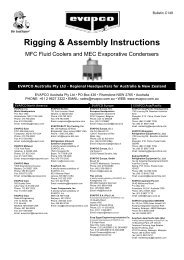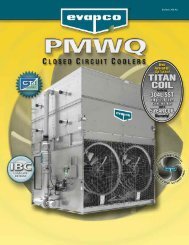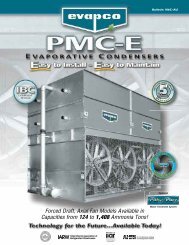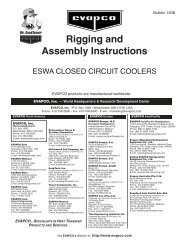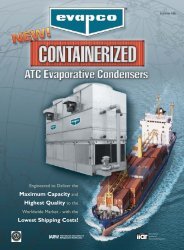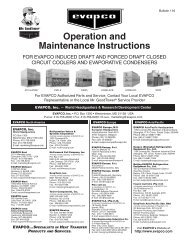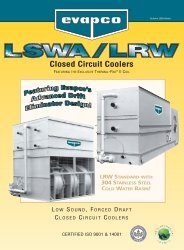For Evapco Fibreglass Cooling Towers, Closed ... - EVAPCO.com.au
For Evapco Fibreglass Cooling Towers, Closed ... - EVAPCO.com.au
For Evapco Fibreglass Cooling Towers, Closed ... - EVAPCO.com.au
You also want an ePaper? Increase the reach of your titles
YUMPU automatically turns print PDFs into web optimized ePapers that Google loves.
Operation and Maintenance Instructions<br />
If any of these items are not properly heat traced and insulated, the ensuing ice formation may result in<br />
<strong>com</strong>ponent failure and c<strong>au</strong>se a shutdown of the cooling unit.<br />
<strong>For</strong> cooling towers, the use of a bypass should also be considered for handling reduced winter loads.<br />
<strong>EVAPCO</strong> re<strong>com</strong>mends that the cooling tower bypass be installed in the condenser water piping system.<br />
Bypasses installed in this manner require a section of piping between the condenser water supply and<br />
return leading to and from the cooling tower.<br />
Never use a partial bypass during cold weather operation. Reduced water flow can result in uneven<br />
water flow over the heat transfer media (fill), which can c<strong>au</strong>se ice formation. Also note that bypasses should<br />
be periodically flushed to minimize stagnant water conditions.<br />
Unit Accessories for Freezing Climates<br />
The appropriate accessories to prevent or minimize ice formation during cold weather operation are<br />
relatively simple and inexpensive. These accessories include cold water basin heaters, the use of a remote<br />
sump, electric water level control and vibration cut out switches. Each of these optional accessories helps<br />
to ensure that the cooling tower will function properly during cold weather operation.<br />
Cold Water Basin Heaters<br />
Optional basin heaters can be furnished with the cooling tower to prevent the water from freezing in the<br />
basin when the unit is idle during low ambient conditions. The basin heaters are designed to maintain 4.5°<br />
C basin water temperature at a -17° C ambient temperature. The heaters are only energized when the<br />
condenser water pumps are off and no water is flowing over the tower. As long as there is a heat load and<br />
water is flowing over the tower, the heaters do not need to operate. Other types of basin heaters to<br />
consider include hot water coils, steam coils and steam injectors.<br />
Remote Sumps<br />
A remote sump located in an indoor heated space is an excellent way to prevent freezing in the cold water<br />
basin during idle or no load conditions bec<strong>au</strong>se the basin and associated piping will drain by gravity<br />
whenever the circulating pump is idle. <strong>EVAPCO</strong> can provide connections in the water basin to<br />
ac<strong>com</strong>modate for remote sump installations.<br />
Electric Water Level Control<br />
Optional electric water level control packages can be furnished to replace the standard mechanical float<br />
and valve assembly. The electric water level control eliminates the freezing problems experienced by the<br />
mechanical float. In addition, it provides accurate control of the basin water level and does not require field<br />
adjustment even under varying load conditions. Please note: the standpipe assembly, make up piping and<br />
solenoid valve must be heat traced and insulated to prevent them from freezing.<br />
Vibration Cut Out Switches<br />
During severe cold weather conditions, ice can form on the fans of cooling towers c<strong>au</strong>sing excessive<br />
vibration. The optional vibration switch shuts the fan off avoiding potential damage or failure of the drive<br />
system.<br />
Capacity Control Methods in Freezing Weather Conditions.<br />
<strong>Cooling</strong> <strong>Towers</strong>: It is very important to maintain close control of the cooling tower during winter operation.<br />
<strong>EVAPCO</strong> re<strong>com</strong>mends that an absolute MINIMUM leaving water temperature of 5.5° C must be<br />
maintained; obviously, the higher the water temperature from the tower, the lower the potential for ice<br />
formation. This assumes that proper water flow over the tower is maintained.<br />
Page 26 of 34 www.evapco.<strong>com</strong>.<strong>au</strong> sales@evapco.<strong>com</strong>.<strong>au</strong>



